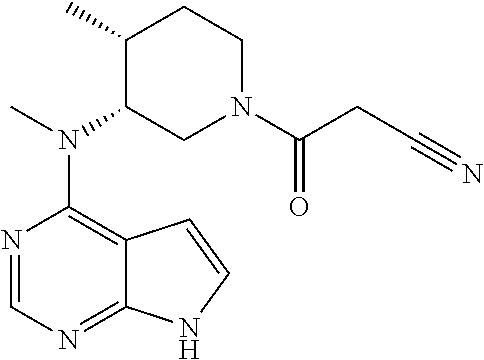Tofacitinib oral sustained release dosage forms
a technology of sustained release and tofacitinib, which is applied in the field of oral sustained release compositions, can solve the problems of compromising the immune system, affecting the safety of human consumption, and affecting the safety of human consumption, and achieves the effect of safe human ingestion
- Summary
- Abstract
- Description
- Claims
- Application Information
AI Technical Summary
Benefits of technology
Problems solved by technology
Method used
Image
Examples
example 1
e Core System Osmotic Tablet
22 mg Tablet Core
[0226]One-half of the batch quantity of sorbitol, 2663.01 grams (also see Table 1 below), was added to a 28 L bin. The batch quantity of Copovidone, 420.00 grams, was then added to the 28 L bin. The batch quantity of Tofacitinib, 623.98 g, was then added to the 28 L bin. The batch quantity of Hydroxycellulose, 560.00 grams, was then added to the 28 L bin. The remaining one-half of the batch quantity of sorbitol, 2663.01 grams was added to the 28 L bin. All of the components were blended in the bin for 15 minutes at 12+ / −1 RPM.
[0227]The blend was passed through a Comil rotary mill equipped with a 0.032″ screen and a round edge impeller running at approximately 950 RPM. The blend was collected in a second 28 L bin. The bin contents were blended for 10 minutes at 15+ / −1 RPM.
[0228]Magnesium stearate, 70 g, was passed through an 850-micron mesh screen and was added to the bin and contents were blended for 5.5 minutes at 12+ / −1 RPM. Final blend...
example 2.200
Example 2. 200 mg Extrudable Core System Osmotic Tablets with Acetone:Methanol Coating Solution
11 mg Tablet Core
[0239]One-half of the batch quantity of sorbitol, 38.014 kilograms (also see Table 5 below), was added to a 300 L bin. The batch quantity of Copovidone, 6.00 kilograms, was then added to the 300 L bin. The batch quantity of Tofacitinib, 8.914 kilograms, was then added to the 300 L bin. The batch quantity of Hydroxycellulose, 8.00 kilograms, was then added to the 300 L bin. The remaining one-half of the batch quantity of sorbitol, 38.014 grams was added to the 300 L bin. All materials were added via a vacuum transfer system and passed through a Comil rotary mill equipped with a 0.032″ screen and a round edge impeller running at approximately 1400 RPM. All of the components are blended in the bin for 20 minutes at 12+ / −1 RPM.
[0240]The blend was passed through a Comil rotary mill equipped with a 0.032″ screen and a round edge impeller running at approximately 1400 RPM. The bl...
example 3.200
Example 3. 200 mg Extrudable Core System Osmotic Tablets Cellulose Acetate and Polyethylene Gycol Coating Membrane
[0252]11 mg and 22 mg tofacitinib sustained release tablet cores were prepared as described in Example 2.
[0253]The 1200-gram coating solution was prepared according to the following steps (see also Table 9): First, 60 grams of water and 19.2 grams of polyethylene gycol were added to a 5-liter vessel and stirred until the solution was clear. 60 grams of methanol and 0.504 grams of BHA were added to the solution and stirred until clear. 1031.496 grams of acetone and 28.8 grams of cellulose acetate were added to the mixture. The contents of the container were mixed for 3 hours. This procedure created a 4% solids (w / w) solution.
[0254]
TABLE 9#MaterialComposition (%)Grams1Cellulose Acetate (Type 398-10)2.400%28.82Polyethylene Glycol (PEG 3350)1.600%19.23Butylated Hydroxyanisole (BHA)0.042%0.5044Purified Water5.000%60.05Methanol5.000%60.06Acetone85.958% 1031.496 100%
[0255]240 ...
PUM
| Property | Measurement | Unit |
|---|---|---|
| time | aaaaa | aaaaa |
| time | aaaaa | aaaaa |
| time | aaaaa | aaaaa |
Abstract
Description
Claims
Application Information
 Login to View More
Login to View More - R&D
- Intellectual Property
- Life Sciences
- Materials
- Tech Scout
- Unparalleled Data Quality
- Higher Quality Content
- 60% Fewer Hallucinations
Browse by: Latest US Patents, China's latest patents, Technical Efficacy Thesaurus, Application Domain, Technology Topic, Popular Technical Reports.
© 2025 PatSnap. All rights reserved.Legal|Privacy policy|Modern Slavery Act Transparency Statement|Sitemap|About US| Contact US: help@patsnap.com

